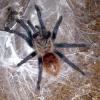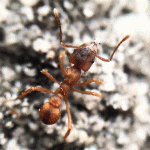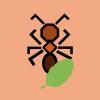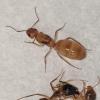What actually would speak against Myrmecocystus testaceus? I found a few pictures only and a few videos but they also look much Lasius like and should be at least 1 cm (0.39 inch) or slightly above right? The legs of my queen are also kind of yellow brownish and the size is a bit large for Lasius. The largest Lasius I know of is Lasius niger with 0.8 cm (0.31 inch). Or are by any chance the Lasius in north america almost as large as Serviformica? This is definately 1-2 mm larger than Lasius niger, too dark for flavus (have here many too + they are smaller in general).
So which Lasius is actually about 0.39 inch long? It is about the same size as my Formica rufibarbis and 100% reaching Formica fusca in size.
Here 2 pictures to see the size comparison. Both test tubes have the same width and I can even see with my own eyes while holding it from different angles that they are about the same size.
The queens were found in California close to the border to Arizona, desert like area. And more than 100s could be easily dug out on that day.
Pictures:
http://www.formicult...940_6190737.jpg
http://www.formicult...940_2206565.jpg
Edited by marcel, August 12 2017 - 9:39 AM.
























